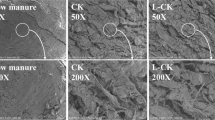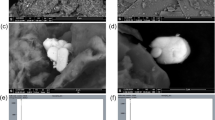Abstract
Adsorption of Co2+ and Cd2+ on Wyoming montmorillonite was studied by the batch equilibration technique, as a function of salt concentration (0.01–4 M NaCl and NaNO3), pH (5.0–6.5), adsorbate concentration (trace-10−2 moles/liter), and presence of complexing ions. Comparison was made with the adsorbability of Sr2+, known to follow simple ion-exchange equations. The distribution coefficients for Co and Cd in noncomplexing media varied with salt concentration (from ∼500 liters/kg in 0.01 M Na+ to ∼10 liters/kg in 1 M Na+; pH = 5), but to a lesser extent than that of St. Adsorbability varied also with pH (∼1 order of magnitude/pH unit), especially at high ionic strength, compared to a negligible pH effect on Sr. The distribution coefficients of Cd and Co decreased with increasing loading on the clay at a very low percentage (0.2%) of the ion-exchange capacity compared to Sr (20%). These data suggest two classes of sites participating in the adsorption of Cd and Co.
The adsorbability of Cd in highly concentrated chloride solution (>1 M) was less than 1 liter/kg, presumably because of the chloride complex formation. This effect increased with increasing pH. The low adsorbability of Cd on montmorillonite from concentrated NaCl solution is promising with respect to its use as a tracer for monitoring flow through formations containing montmorillonite.
Резюме
С помощью метода дозированного равновесия изучалась адсорбция Co2+ и Cd2+ монтмориллонитом из Вайоминга, как функция контцентрации соли (0,01–4 M NaCl и NaNO3), рН (5,0–6,5), концентрации адсорбата (след = 10−2 мол/литр) и присутствия составляющих ионов. Было проведено сравнение с поглощаемостью Sr2+, которая, как известно, описывается простым уравнением ионного обмена. Коэффициенты распределения для Со и Сё в некомплексной среде изменялись с изменением концентрации соли (от —500 литров/кг в 0,01 M Na+ до ~10 литров/кг в 1 M Na+; рН = 5), но в меньшей степени, чем коэффициент для 8г. Поглощаемость также изменялась с изменением рН (~1 порядок величины/единица рН), особенно при высокой ионной силе, по сравнению с незначительным влиянием рН на 8г. Коэффициенты распределения Си и Со уменьшались с повышением нагрузки на глину при очень низком проценте (0,2%) ионной обменной способности по сравнению с Sr (20%). Эти данные указывают на существование двух классов мест участвующих в адсорбции Cd и Co. Поглощаемость Cd в сильно концентрированном хлоридном растворе (>1 M) была меньше, чем 1 литр/кг, предположительно из-за формирования хлоридного комплекса. Этот эффект возрастал с увеличением рН. Низкая поглощаемость Си монтмориллонитом из концентрированного раствора NaCl является обещающей в отношении его использования в качестве индикатора для наблюдения за потоком через формации, содержащие монтмориллонит. [N.R.]
Resümee
Die Adsorption von Co2+ und Cd2+ an Montmorillonit von Wyoming wurde mittels der batch equilibration-Methode untersucht in Abhängigkeit von der Salzkonzentration (0,01–4 M NaCl und NaNO3), dem pH (5,0–6,5), der Konzentration des zu adsorbierenden Ions (Spuren-10−2 Mol/Liter) und der Anwesenheit von komplexbildenden Ionen. Ein Vergleich wurde gezogen mit der Adsorbierbarkeit von Sr2+, die bekanntlich einfachen Ionenaustauschgleichungen folgt. Die Verteilungskoeffizienten yon Co und Cd in nicht-komplexbildenden Medien variierten mit der Salzkonzentration (von ∼500 Liter/kg in 0,01 M Na+ bis ∼10 Liter/kg in 1 M Na+; pH = 5), aber in einem geringeren Ausmaß als der Verteilungskoeffizient von Sr. Die Adsorbierbarkeit variierte auch mit dem pH (∼1 Größenordnung/pH-Einheit), vor allem bei hoher Ionenstärke, verglichen mit dem zu vernachlässigenden Effekt des pH im Fall von Sr. Die Verteilungskoeffizienten von Cd und Co nehmen mit zunehmender Beladung des Tons nur um einen sehr kleinen Prozentsatz (0,2%) der Ionenaustauschkapazität ab, verglichen mit Sr (20%). Diese Ergebnisse deuten darauf hin, daß es zwei Arten yon Positionen gibt, die an der Adsorption von Cd und Co beteiligt sind.
Die Adsorbierbarkeit yon Cd in hochkonzentrierten Chloridlösungen (>1 M) war weniger als 1 Liter/kg, wahrscheinlich wegen der Bildung yon Chloridkomplexen. Dieser Effekt vergrößert sich mit zunehmendem pH. Die geringe Adsorbierbarkeit von Cd an Montmorillonit aus konzentrierten NaCl-Lösungen ist vielversprechend im Hinblick auf ihre Verwendbarkeit als Tracer für den Durchfluß durch Montmorillonithältige Formationen. [U.W.]
Résumé
L’adsorption de Co2+ et de Cd2+ sur de la montmorillonite du Wyoming a été étudiée par une technique d’équilibration de l’entièreté de l’échantillon en fonction de la concentration de sel (0,01–4 M NaCl et NaNO3), du pH (5,0–6,5), de la concentration d’adsorbat (trace-10 2 moles/litre), et de la prgsence d’ions complexants. Une comparaison a été faite avec l’adsorbabilité du Sr2+ qui suit les équations simples d’échange d’ions. La distribution de coefficients pour le Co et le Cd darts un milieu non complexant a varié avec la concentration de sel (de ∼500 litres/kg dans 0,01 M Na+ à ∼10 litre/kg dans 1 M Na+; pH = 5), mais dans une moindre mesure que Sr. L’adsorbabilité a aussi varié avec le pH (∼1 ordre de grandeur/unité de pH), spécialementen haute force ionique, comparé à l’effet négligeable du pH sur le St. Les coefficients de distribution de Cd et de Co ont décru avec un accroissement de la charge sur l’argile à un très bas pourcentage (0,2%) de la capacité d’échange d’ions, comparé à Sr (20%). Ces données suggèrent 2 classes de sites participant à l’adsorption de Cd et de Co.
L’adsorbabilité de Cd darts une solution de chlorure très concentrée (>1 M) était moins d’un litre/kg, sans doute à cause de la formation du complexe chlorure. Cet effet a augmenté avec l’accroissement de pH. La basse adsorbilité de Cd sur la montmorillonite à partir d’une solution concentrée de NaCl est promettante en function de son emploi comme traceur pour contrôler un flux à travers les formations contenant de la montmorillonite. [D.J.]
Similar content being viewed by others
References
Doner, H. E. (1978) Chloride as a factor in mobilities of Ni(II), Cu(II) and Cd(II): Soil Sci. Soc. Amer. J. 42, 882–885.
Farrah, H. and Pickering, W. F. (1976) The sorption of copper species by clays: Aust. J. Chem. 29, 1177–1184.
Farrah, H. and Pickering, W. F. (1977) Influence of clay-solute interaction on aqueous heavy metal ion levels: Water Air Soil Pollution 8, 189–197.
Ferrell, Jr., R. E. and Price, C. A. (1978) An experimental study of cadmium ion exchangeability: Clays & Clay Minerals 26, 41–44.
Frost, R. R. and Griffin, R. A. (1977) Effect of pH on adsorption of copper zinc and cadmium from landfill leachate by clay minerals: J. Environ. Sci. Health A12, 139–156.
Garcia, Miragayal, and Page, A. L. (1976) Influence of ionic strength and inorganic complex formation on sorption of trace amount of Cd by montmorillonite: Soil Sci. Soc. Amer. J. 40, 658–663.
Hodgson, J. F. (1960) Cobalt reaction with montmorillonite: Soil Sci. Soc. Proc. 24, 165–168.
Jackson, M. L. (1956) Soil chemical analysis—advanced course: published by the author, Dept. of Soils, Univ. of Wisconsin, Madison, Wisconsin.
Kinniburgh, D. G., Jackson, M. L., and Syers, J. K. (1976) Adsorption of alkaline earth, transition and heavy metal cations by hydrous oxide gels of iron and aluminum: Soil Sci. Amer. J. 40, 796–799.
Kinniburgh, D. G., Syers, J. K., and Jackson, M. L. (1975) Specific adsorption of trace amounts of calcium and strontium by hydrous oxides of iron and aluminum: Soil Sci. Soc. Amer. Proc. 39, 464–470.
Kraus, K. A. and Nelson, F. (1959) Anion exchange studies of metal complexes: in The Structure of Electrolytic Solutions, W. J. Hamer, ed., Wiley, New York, 340–364.
Kraus, K. A., Phillips, H. O., Carlson, T. A., and Johnson, J. S. (1960) Ion exchange properties of hydrous oxides: Progress in Nuclear Energy, Series IV, 28, Pergamon Press, Oxford, 3–16.
Levy, R. and Francis, C.S. (1976) Adsorption and desorption of cadmium by synthetic and natural organo clay complexes: Geoderma 15, 361–370.
Maes, A. and Cremers, A. (1975) Cation exchange hysteresis in montmorillonite—a pH-dependent effect: Soil Science 119, 198–202.
Maes, A., Peigneur, P., and Cremers, A. (1975) Thermodynamics of transition metal ion exchange in montmorillonite: in Proc. Int. Clay Conf, Mexico City, 1975, S. W. Bailey, ed., Applied Publishing, Wilmette, Illinois, 319–329.
Nelson, F., Murase, T., and Kraus, K. A. (1964) Cation exchange in concentrated HCl and HC104 solutions: J. of Chromatogr. 13, 503–535.
Peigneur, P., Maes, A., and Cremers, A. (1975) Heterogeneity of charge density distribution on montmorillonite as inferred from cobalt adsorption: Clays & Clay Minerals 23, 71–75.
Shiao, S-Y., Rafferty, P., Meyer, R. E., and Rogers, W. J. (1978) Ion exchange equilibria between montmorillonite and solutions of moderate to high ionic strength: ACS Symposium 100, 297–324.
Smith, R. M. and Martell, A. E. (1976) Critical stability constants: Inorganic Complexes, vol. 4, Plenum Press, New York, 104–112.
Author information
Authors and Affiliations
Additional information
Research sponsored by the Division of Fossil Fuel Extraction, U.S. Department of Energy under contract W-7405-eng-26 with Union Carbide Corporation.
Rights and permissions
About this article
Cite this article
Egozy, Y. Adsorption of Cadmium and Cobalt on Montmorillonite as a Function of Solution Composition. Clays Clay Miner. 28, 311–318 (1980). https://doi.org/10.1346/CCMN.1980.0280410
Received:
Accepted:
Published:
Issue Date:
DOI: https://doi.org/10.1346/CCMN.1980.0280410




